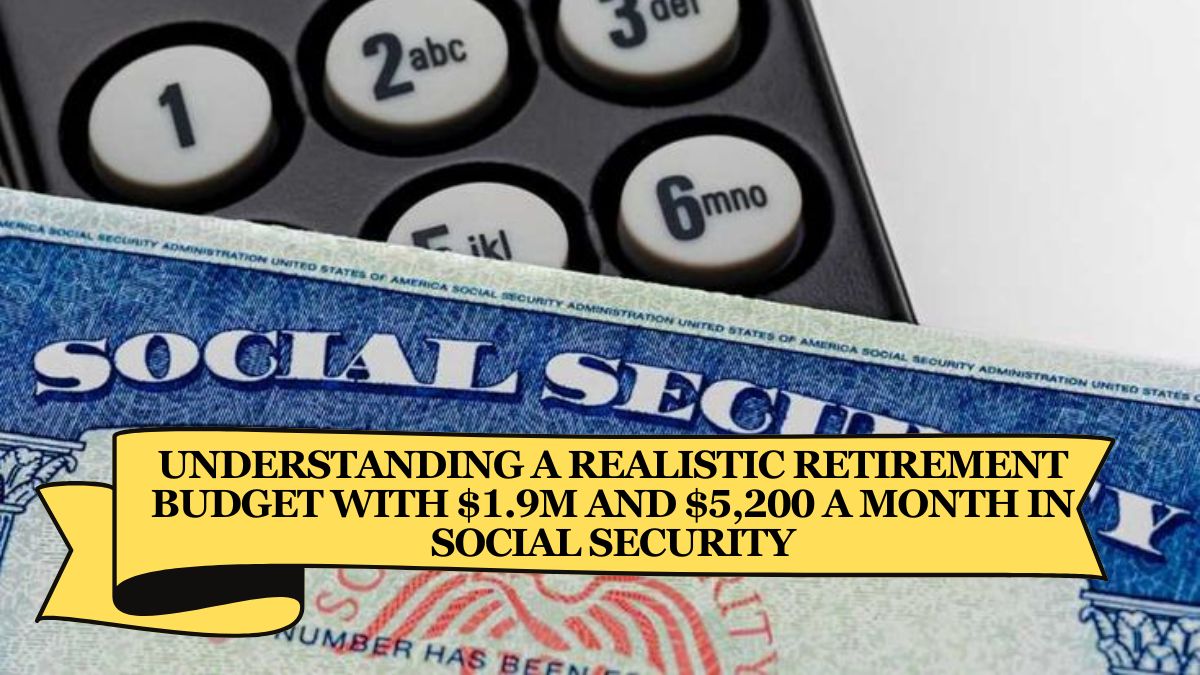When planning for retirement, it’s essential to have a clear understanding of both income sources and expenses. This can help you live comfortably and avoid financial surprises. For many, retirement income includes Social Security and savings, such as 401(k) or IRA funds. In this article, we will look at how a couple with $1.9 million in retirement savings and $5,200 a month in Social Security benefits can plan their retirement budget effectively.
Assessing Your Income for Retirement
As you approach retirement age, the first step is determining how much income you’ll need and how much you’ll be receiving. Social Security plays a significant role in this. For a couple, $5,200 per month, or $62,400 annually, is the expected income from Social Security. But there’s also your savings to consider, especially if you’ve built a nest egg like $1.9 million.
You’ll need to generate investment income from this amount, but keep in mind that the earlier you retire, the more you’ll depend on your savings. If you choose to wait until you reach your full retirement age of 67, your Social Security benefit will increase. This means a potentially higher monthly payout.
Applying the 4% Rule
One common method for determining how much you can withdraw from your savings each year is the 4% rule. This rule suggests that you can safely withdraw 4% of your total savings each year without running out of money too soon. In your case, with $1.9 million in savings, applying the 4% rule would suggest you could withdraw $76,000 in the first year of retirement.
Since inflation tends to increase over time, you can adjust your withdrawals accordingly. For example, if inflation rises by 3% in the second year, your withdrawal amount would increase by that percentage, bringing it to $78,280.
Combining Social Security with Investment Withdrawals
When you combine your investment withdrawals and Social Security benefits, your total income in the first year could be around $138,400. This would cover many expenses and allow for a comfortable lifestyle. However, your personal lifestyle choices will determine whether this income is enough. If you were earning around $172,000 before retirement, $138,400 should be enough to maintain your standard of living, but if you were earning more, you might need to reconsider your budget.
Estimating Your Retirement Expenses
Understanding how much you’ll need to spend during retirement is just as important as knowing your income. As a general guideline, you should anticipate requiring between 70% and 90% of your pre-retirement income. If you used to earn $172,000 per year, applying the 80% figure means you would need approximately $138,400 annually to maintain your pre-retirement lifestyle.
If your current living expenses are higher than that, you might need to adjust your spending habits. For example, reducing discretionary expenses, downsizing your home, or cutting back on non-essential purchases could help you stay within your budget.
Tax Considerations in Retirement
In retirement, taxes still play a role. Since your retirement accounts (401(k), IRA) are not Roth IRAs, you’ll have to pay taxes on your withdrawals. For example, in 2024, married couples who are both 65 and older can deduct $32,200 from their taxable income. This would reduce your taxable income to $106,200 after deductions.
Since your Social Security income is more than $34,000, 85% of it is taxable, meaning you’ll owe taxes on $53,040 of your Social Security benefits. After tax deductions, your taxable income would be $96,840. According to 2024 tax rules, this puts you in the 22% tax bracket, which means your tax bill could be approximately $11,715.
The Role of Required Minimum Distributions (RMDs)
Once you turn 73, you’ll be required to start withdrawing a certain amount from your retirement accounts. These withdrawals are called Required Minimum Distributions (RMDs). Your first RMD will likely be around $71,698, and it will be taxable. However, since your initial withdrawals from your retirement account ($76,000) are higher than the RMD, this won’t significantly impact your overall tax situation unless circumstances change.
Long-Term Care and Unexpected Expenses
Planning for long-term care is another important aspect of retirement planning. Healthcare costs, especially for long-term care, can be a huge financial burden. The cost of a semi-private room in a skilled nursing facility can be as high as $94,000 annually. This is a significant portion of your retirement income and could affect your ability to maintain your current lifestyle.
To protect against these costs, you might want to consider long-term care insurance. However, premiums for such insurance can be high, especially if you wait until you are older to purchase it. Additionally, once you reach age 70 or if you have health issues, it may be difficult to qualify for coverage.
Retirement Planning Tips
Planning for retirement involves careful preparation. To ensure you have enough income for the long term, consider consulting a financial advisor. They can help you navigate the complexities of tax planning, investment management, and long-term care options.
Additionally, keep an emergency fund on hand for unexpected expenses. This fund should be liquid, meaning it’s easily accessible but not exposed to market risks, such as the volatility of the stock market. You can use high-interest savings accounts to grow your emergency fund over time.
Finally, use retirement calculators to model different scenarios. This can help you determine if your current savings and income will be enough to cover your future needs.
Building a solid retirement budget requires a balance between knowing your income sources, managing your expenses, and planning for unexpected events. With $1.9 million in savings and $5,200 a month from Social Security, you can set yourself up for a comfortable retirement. However, to ensure long-term financial security, it’s essential to plan for taxes, healthcare costs, and other potential expenses. Consulting with a financial advisor and using tools like retirement calculators can help you make informed decisions and adjust your plans as needed.
You Must Visit: California State Online

